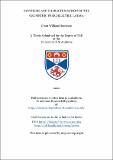Files in this item
Synthesis and characterisation of the geometric ferroelectric LaTaO₄
Item metadata
| dc.contributor.advisor | Morrison, Finlay | |
| dc.contributor.author | Howieson, Grant William | |
| dc.coverage.spatial | 167 | en_US |
| dc.date.accessioned | 2023-03-27T15:56:52Z | |
| dc.date.available | 2023-03-27T15:56:52Z | |
| dc.date.issued | 2022-06-15 | |
| dc.identifier.uri | https://hdl.handle.net/10023/27273 | |
| dc.description.abstract | LaTaO₄ is one of very few reported n=2 Carpy-Galy oxides. It is isostructural to the BaMF₄ fluorides which were subject of much prior study due to their ferroelectric and multiferroic properties. Previous studies of LaTaO₄ have been consistent in their conclusion that it can adopt either a low temperature non-polar monoclinic, or high temperature polar orthorhombic phase, with the monoclinic – orthorhombic transition temperature (Tₘ₋ₒ) being dependent on the preparation method. Recent studies, however, have reported an unidentified dielectric anomaly in the orthorhombic phase which alludes to an additional subtle structural transition above Tₘ₋ₒ. Powder neutron (PND) and electron diffraction studies have revealed that the previously unidentified dielectric anomaly denotes a transition between an incommensurately modulated and unmodulated orthorhombic (Cmc2₁) structure at ~503 K. The phase transition sequence is re-investigated in light of this new modulated phase, with resonant ultrasound (RUS) and Raman spectroscopy being utilised to elucidate the dynamics of transition and show the incommensurate – commensurate transition to be unusually 1ˢᵗ order, but nearly continuous (tri-critical). Refinement of PND data in the Cmc2₁(α00)0s0 superspace group, indicates a modulation wavevector q = (0.456 0 0) at 483 K. The modulation arises from a variation in La³⁺ positions and octahedral tilts which propagate along the polar a-axis and is speculated to arise as a mechanism to improve overall bonding environment of La³⁺. Electron microscopy reveals that the modulation arises from partially ordered sub-units, which are 2.5× and 3× expansions of the original orthorhombic cell. A model has been constructed which combines the local structural origin with the observed macroscopic modulation, where sub-units partially order with an average periodicity of ~11a (~0.456 a*). Previous studies report a relationship between the stability of each phase of LaTaO₄ and A-cation size. To explore the possibility that the modulation arises purely by an A-cation size effect, the series La₁₋ₓLnₓTaO₄ is synthesized, where Ln = Ce³⁺, Pr³⁺ and Nd³⁺ (0 ≤ x ≤ 0.3). Doping with these isovalent cations shows a general trend of stabilisation of the low temperature phases with decreasing average A-cation radii; the effect is amplified in Ce³⁺-doped samples and preliminary analysis suggests that this is due to a mix of oxidation states and the associated inter- and de-intercalation of interstitial oxygens during thermal cycling. | en |
| dc.language.iso | en | en_US |
| dc.relation | Synthesis and Characterisation of the Geometric Ferroelectric LaTaO4 (thesis data) Howieson, G. W. University of St Andrews, 9 Nov 2023. DOI: 10.17630/a7540ced-d4a3-4c89-a93f-6e21dc2b4c01. | |
| dc.relation.uri | https://doi.org/10.17630/a7540ced-d4a3-4c89-a93f-6e21dc2b4c01 | |
| dc.title | Synthesis and characterisation of the geometric ferroelectric LaTaO₄ | en_US |
| dc.type | Thesis | en_US |
| dc.contributor.sponsor | Engineering and Physical Sciences Research Council (EPSRC) | en_US |
| dc.contributor.sponsor | University of St Andrews. School of Chemistry | en_US |
| dc.type.qualificationlevel | Doctoral | en_US |
| dc.type.qualificationname | PhD Doctor of Philosophy | en_US |
| dc.publisher.institution | The University of St Andrews | en_US |
| dc.rights.embargoreason | Embargo period has ended, thesis made available in accordance with University regulations | en |
| dc.identifier.doi | https://doi.org/10.17630/sta/369 | |
| dc.identifier.grantnumber | EP/P024637/1 | en_US |
This item appears in the following Collection(s)
Items in the St Andrews Research Repository are protected by copyright, with all rights reserved, unless otherwise indicated.

